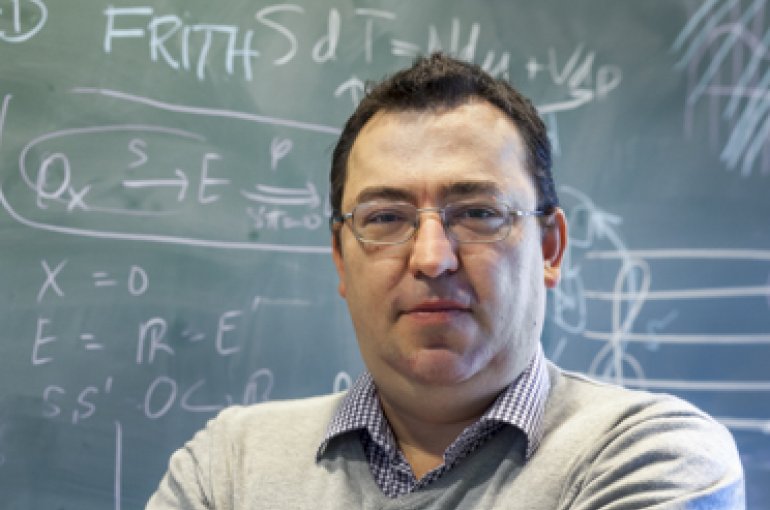Mathematician Prof. Marius Crainic receives first De Bruijn Prize
For the most influential publications by Dutch mathematicians

Prof. Marius Crainic from Utrecht University has been presented with the first N.G. de Bruijn Prize by the Royal Dutch Mathematical Society. He was honoured with the prize for two publications that he wrote together with Doctoral Candidate Camilo Arias Abad. According to the jury, these were the most influential publications by Dutch mathematicians during the period 2011-2014. Their research has already been used by many others, which in turn has led to important new insights. “I expect that this subject will continue to develop, with the work of Crainic and Abad at its heart”, according to president of the jury Prof. Henk Broer of Groningen University.
Groups are the mathematical objects that encode symmetries of one geometrical shape or one equation. Groupoids are generalisations of groups which also take into account symmetries between possibly different objects. Crainic and Abad found a way to represent groupoids in a simpler, linear, fashion. While such a theory for groups began development more than 100 years ago and is now very well understood, the similar notion for groupoids turned out to be more subtle. “We have now discovered the fundamental notion that was missing, and we expect it to be the basis of new research similar to current research on groups” explains Crainic.
Risky research
The kernel of a possible solution had been bubbling in his head for some time, he says. But it was his permanent appointment that made it possible for him to start working on the subject. “This is risky research, because you don’t know if it will eventually lead to anything. It’s the kind of discovery that looks very simple, but it’s not, because you don’t know what it is you’re after. It’s my philosophy that the most important work, but also the most difficult, is to discover the obvious.”
Too simple-minded
As is the case with groups, one represents groupoids linearly. That means ‘as simple as possible’, while still giving a very good approximation. “Not ‘ex’, but ‘1 + x’”, gives Crainic as example. But as groupoids are more complicated than groups, the obvious generalisation from groups to groupoids failed: it was too simple-minded and excluded important examples.
The main idea
The main idea of Crainic and Abad was to relax this simpler notion of representation: they do not have to meet the requirements for the full 100 percent, but only a weaker version of them. Or, in more mathematical terms, the requirements are required to hold only ’up to homotopy’. Intuitively, this corresponds to the property that two geometrical spaces or equations can deform into each other in a continuous manner.
The outcome: many more representations
Thanks to the more flexible notion, groupoids now permit many more representations, as was already the case for groups. This opens up several new lines of research on and using groupoids, such as classification results (based on the fact that ’the adjoint representation’ now makes sense), understanding the possible deformations of groupoids, or the process of recovering completely a groupoid from its representations (known as Tannaka-Krein duality).
Applications
Groupoids are used both in mathematics and mathematical physics, but Crainic thinks that it is useless to speculate on concrete applications of his research. “The path from our research to possible applications is so long, that you can only determine what our research has made possible after the fact. We have discovered a fundamental notion that people will probably continue to use more and more and will still be used in 2116, although by then probably nobody will remember that we were the ones who did it.”
Own judgement
He is pleased that the risky research project has resulted in a doctoral dissertation, but for him the work on this subject is now complete. He is especially happy for the relevance De Bruijn Prize to the Dutch mathematics community. “I often have had the feeling that here, in The Netherlands, you receive recognition only if you earn acclaim abroad. This prize shows that the Dutch mathematics community has confidence in its own judgement. I think that that is a positive development.”
De Bruijn Prize
The biannual N.G. De Bruijn Prize is named after mathematician Prof. Dick de Bruijn, who passed away in 2012 at the age of 93. De Bruijn published more than 190 oft-cited articles on a wide range of mathematical subjects. The prize includes a medal and a monetary award of 4.000 Euros.
Marius Crainic
Marius Crainic (1973), received his Bachelor’s degree in Mathematics in his native Romania, obtained his Master’s degree in Nijmegen and took his PhD at Utrecht University under supervision of Professor Ieke Moerdijk. After an appointment at Berkeley University, he returned to Utrecht as KNAW Research Fellow. In 2002 he received a permanent appointmet at Utrecht University, and in 2012 he was appointed Professor in Geometry and Topology.
Crainic was awarded a Vidi in 2007, an ERC Starting Grant in 2011 and a Vici in 2014. He also received a number of distinctions, among them the prestigious Andre Lichnerowicz Prize in Poisson Geometry in 2008.

